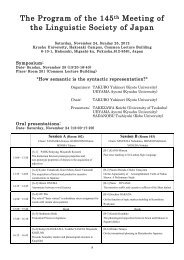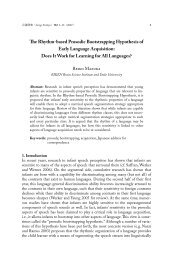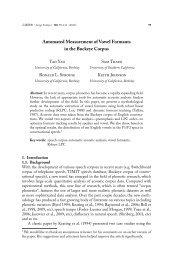第117åæ¥æ¬è§£åå¦ä¼ç·ä¼ã»å ¨å½å¦è¡éä¼ è¬æ¼ããã°ã©ã ã»æé²é PDF ...
第117åæ¥æ¬è§£åå¦ä¼ç·ä¼ã»å ¨å½å¦è¡éä¼ è¬æ¼ããã°ã©ã ã»æé²é PDF ...
第117åæ¥æ¬è§£åå¦ä¼ç·ä¼ã»å ¨å½å¦è¡éä¼ è¬æ¼ããã°ã©ã ã»æé²é PDF ...
Create successful ePaper yourself
Turn your PDF publications into a flip-book with our unique Google optimized e-Paper software.
117 153<br />
P<br />
<br />
<br />
<br />
<br />
SEM <br />
<br />
<br />
75 mM KCl <br />
<br />
<br />
SEM <br />
<br />
SEM <br />
<br />
<br />
<br />
<br />
SEM <br />
<br />
P<br />
Communication between Flagellar Outer and Inner Dynein Arms<br />
Toshiyuki Oda, Toshiki Yagi, Masahide Kikkawa<br />
Dept. Cell Biology, Univ. Tokyo, Grad. Sch. Medicine<br />
The beating motion of cilia and flagella is driven by two rows of dynein arms:<br />
the outer dynein arms ODA and the inner dynein arms IDA. The ODAs are<br />
required to generate the normal beat frequency and the IDAs are responsible for<br />
the amplitude of the waveform. Although structural connections between the ODA<br />
and the IDA have been observed by cryoelectron tomography, the functional<br />
communication between the two species of the dynein arms has not been<br />
elucidated. In this study, we investigated the roles of the two intermediate chains<br />
IC1 and IC2 of Chlamydomonas ODA. We located the positions of the termini<br />
of the ICs within the ODAmicrotubule complexes by biotinstreptavidin labeling<br />
and cryoelection microscopy. It is noteworthy that the location of the Nterminus<br />
of IC2 is close to the previously observed ODAIDA linker. The biotintag added<br />
to the Nterminus of IC2 reduced the amplitude of the beating by half while the<br />
beat frequency was not decreased. These results suggest the Nterminus of IC2<br />
mediates the communication between the ODA and the IDA.<br />
P<br />
A novel protein complex required for the formation of microtubule<br />
square lattice in green tree frog sperm<br />
Toshiki Yagi 1 , Hiroshi Kubota 2 , Masahide Kikkawa 1<br />
1<br />
Grad. Sch. Medicine, Univ. Tokyo, 2 Grad. Sch. Science, Kyoto Univ.<br />
Fertilization of the green tree frog occurs in the viscous environment of a foam<br />
nest laid on the vegetation. The sperm cell moves through viscous media by<br />
spinning of the spiral head with flagellar bending movements. Previous EM<br />
analysis showed that the flagellum is composed of a pair of axonemes surrounded<br />
by a regular square lattice of hundreds of satellite microtubules MTs. To<br />
understand how the unique MT lattice structure forms, here we purified MT<br />
bundling proteins from the flagella and examined the properties of the proteins.<br />
Sperm cells were fragmented and fractionated into heads and short flagella by<br />
sonication and centrifugation. Proteins with MT bundling activity was purified<br />
from high salt extract of demembranated flagella by gel filtration chromatography.<br />
This fraction contained six proteins with the molecular size of 3545 kDa. All the<br />
proteins were precipitated together by MTpelleting assay, suggesting that they<br />
form a complex with MT. EM analysis on salt extracted sperm showed that the<br />
flagella lost crosslink structures in the MT lattice. Taken together, we suggest that<br />
the protein complex constitutes the crosslink structure required for the MT lattice<br />
formation.<br />
P<br />
<br />
<br />
<br />
<br />
<br />
<br />
LH/FSH <br />
<br />
<br />
LH/FSH <br />
TGN38 trans γtubulin<br />
<br />
<br />
cistrans <br />
<br />
<br />
<br />
<br />
<br />
<br />
<br />
P<br />
Mitochondria form continuous intracellular networkstructures: a<br />
study visualized by highresolution scanning electron microscopy<br />
Tomonori Naguro, Hironobu Nakane, Sumire Inaga<br />
Division of Genome Morphology, Fac. Medicine, Tottori Univ.<br />
The mitochondria of rat olfactorybulb granule cells in vivo cells within the<br />
tissue formed a continuous network of various shapes in each cell. On the basis<br />
of the morphological characteristics, these mitochondrial networks were roughly<br />
classified into four groups: Type1: Mitochondrial networks are composed of<br />
a single branched tubule of almost uniform thickness, 250300 nm. Type2:<br />
Distinguished by thickness, mitochondrial networks have two kinds of tubules:<br />
about 250350 nm and 100 nm across, respectively. Type3: Mitochondrial<br />
networks are composed of two parts; a globular part around 1.0 μm in diameter<br />
and a filamentous part about 45100 nm across. Type4: Highly complex<br />
mitochondrial networks consisting of elements those vary in shape.<br />
The significance of this morphological diversity of mitochondrial networks<br />
is discussed referring to recent studies with other means, notably light and<br />
transmissionelectron microscopy while considering the advantages and<br />
disadvantages of scanning electron microscopy methods employed for this here.<br />
P<br />
<br />
<br />
<br />
<br />
<br />
Mt <br />
C57BL/6 <br />
1 5 <br />
2<br />
2.5<br />
<br />
<br />
<br />
Mt Mt <br />
1 <br />
Mt Mt <br />
5 Mt <br />
Mt <br />
<br />
Mt <br />
Mt <br />
Mt







